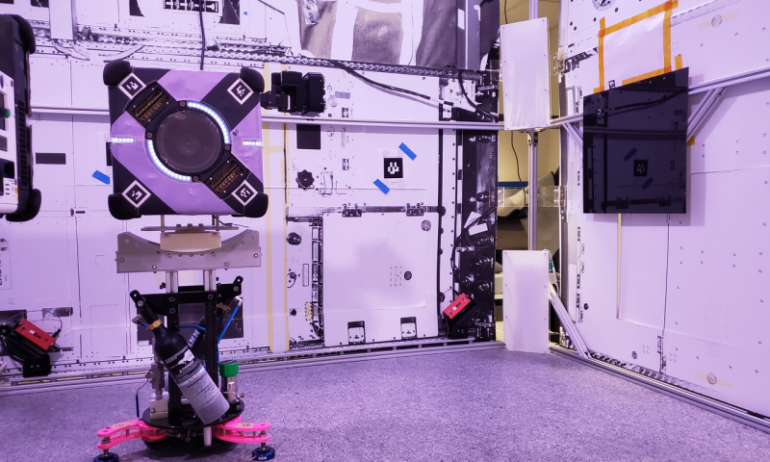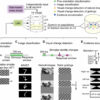Robots that can fly autonomously in space, also known as free-flying robots, could soon assist humans in a variety of settings. However, most existing free-flying robots are limited in their ability to grasp and manipulate objects in their surroundings, which may prevent them from being applied on a large-scale.
Two labs at Stanford University, namely the Biomimetics & Dexterous Manipulation Lab (BDML) and the Autonomous Systems Lab (ASL), have been trying to develop gecko-inspired technologies that could enhance the manipulation capabilities of free-flying robots. The BDML group at Stanford has expertise in the manufacturing and use of gecko-inspired adhesives for robotics applications, while the ASL team focuses on the development of algorithms that equip free-flyers with autonomous capabilities.
The new gripper created by these two labs, set to be presented at the i-SAIRAS conference and introduced in a paper pre-published on arXiv, was applied to the Astrobee, a free-flying robotic system developed at NASA. The project was funded by a NASA Early Stage Innovations grant, which is designed to support teams who are developing gecko-inspired technologies that can be applied to free-flying robots on the International Space Station (ISS).
“Working together, our two labs were interested in equipping free-flyers in space with gecko-adhesives, in order to allow them to complete a rich set of tasks,” Abhishek Cauligi and Tony Chen, lead researchers on the project, told TechXplore. “For example, a pie-in-the-sky goal one day would be that an astronaut asks for Astrobee to go retrieve a tool from another module of the ISS. The Astrobee robot then has to interpret this command, make high-level decisions of where it should go to find this tool, compute a trajectory for how it should get there and once it arrives, pick up the tool.”
While the use of Astrobee robots for object retrieval on the ISS is a remote possibility at the moment, Cauligi, Chen, and their colleagues set out to design and demonstrate the potential of the key components that could enable this use. The goal of their recent work was to equip free-flying robots, such as the Astrobee, with a gecko-adhesive gripper, allowing them to compute desirable trajectories and attach to the interior wall of the ISS.
The researchers closely collaborated with scientists at NASA to design a gripper that could be integrated onto the current version of the Astrobee and that would be safe to launch to the ISS. Most existing robotic grippers are based on a “claw-like” mechanism, which allows them to grapple or pinch around objects to securely grasp them.
This mechanism can be very limiting for free-flying robots that are meant to operate in space, as these robots might need to grasp objects of varying shapes and sizes under unfavorable environmental conditions. Grippers inspired by how the feet of geckos attach to surfaces could be far more effective, as they may also allow robots to grasp objects with unusual and unfavorable geometries.
“Each gecko toe consists of hundreds of microscopic structures called setae; these structures collapse when force is applied to it and expand in surface area,” Cauligi said. “While this force is held in place, adhesion forces known as van der Waals forces induce adhesion between the structures and the surface they’re attached to. To remove this adhesion, the force applied on the structures simply has to be released.”
The physical process that allows geckos to attach to surfaces does not rely on glue or other sticky substances. In addition, this process also works in a vacuum and in space, generalizing well across different types of smooth surfaces.
These desirable properties have made gecko-inspired adhesives for space applications the focus of a growing number of research studies. In the past, for instance, the BDML and ASL labs explored the potential of using gecko-inspired grippers to tackle the problem of space debris, allowing robots to pick up and remove pieces of spacecraft, satellites or other refuse that is fluctuating in space.
“The BDML has looked into the use of gecko-inspired adhesives for a broad set of applications within robotics, whether it be with drones or tug robots,” Cauligi said. “Over the past few years, both BDML and ASL have worked together to specifically study their applications for use with free-flying robots such as Astrobee and have published extensively on this topic.”
In their recent paper, Cauligi, Chen and their colleagues outline the design of their gecko-inspired gripper, as well as details of how it could be integrated on the Astrobee robot. Working with researchers at NASA Ames, they recently completed the final steps necessary to start applying the gecko-adhesive gripper on Astrobee robots operating on the ISS.
In July of 2019, two of their grippers were sent to the ISS aboard of a SpaceX Falcon 9 rocket, along with the first set of Astrobee robots. The grippers will be tested in a series of on-orbit experiments that are scheduled to take place on the ISS in early 2021.
“As student researchers, it’s been a unique opportunity to work on the full lifetime of this project, starting from a novel research idea and leading to a prototype that is orbiting the Earth today,” Cauligi said. “Of course, this work wouldn’t have been possible without the support of our collaborators at the Intelligent Robotics Group at NASA Ames. Along the way, we’ve learned much from them, visited multiple NASA research centers to certify our grippers, and even watched a SpaceX launch in person.”
The experiments that are set to be carried out on the ISS over the next few months will help to ascertain the effectiveness of the robotic gripper developed by Cauligi, Chen and their colleagues. In addition, the team hopes that these tests will unveil the key strengths and limitations of the technology they developed, allowing them to further improve its performance in the future.
“In addition to investigating the potential of the gecko-adhesive technology itself, we now plan to run experiments that explore the trajectory generation aspect of the problem for how Astrobee gets from point A to point B, using novel tools from the fields of optimization and machine learning,” Cauligi said. “Further down the road, we would like to look into the ‘pie-in-the-sky’ problem we described earlier, where we equip Astrobee with all the tools necessary for it to work alongside and assist astronauts carrying out activities on the ISS.”
Astrobee’s first robot completes initial hardware checks in space
More information:
Design and development of a gecko-adhesive gripper for the Astrobee free-flying robot. Int. Symp. on Artificial Intelligence, Robotics and Automation in Space (2020).
arxiv.org/abs/2009.09151
2020 Science X Network
Citation:
A gecko-adhesive gripper for the Astrobee free-flying robot (2020, October 20)
retrieved 21 October 2020
from https://techxplore.com/news/2020-10-gecko-adhesive-gripper-astrobee-free-flying-robot.html
This document is subject to copyright. Apart from any fair dealing for the purpose of private study or research, no
part may be reproduced without the written permission. The content is provided for information purposes only.



